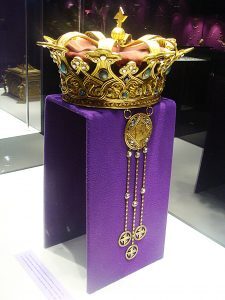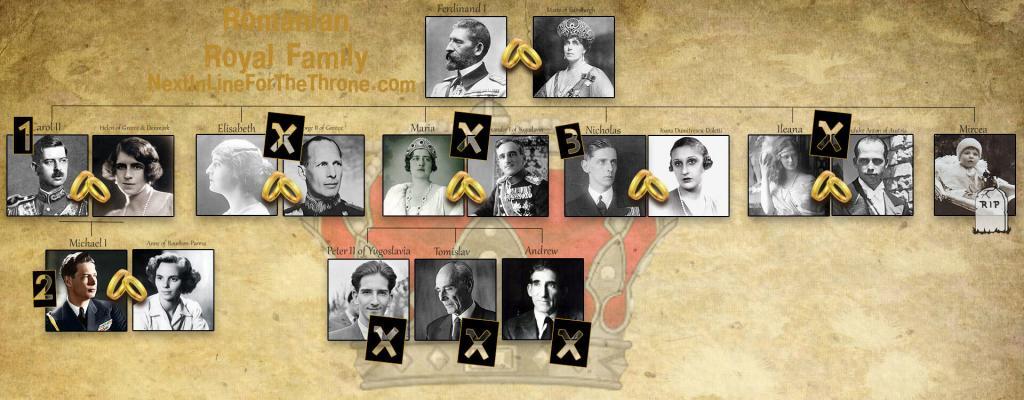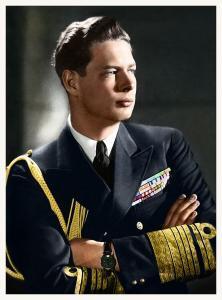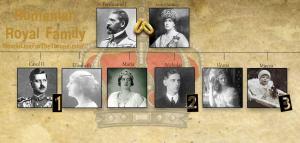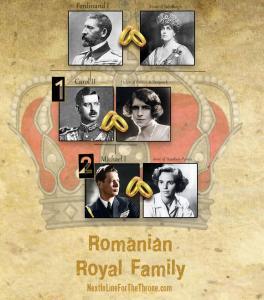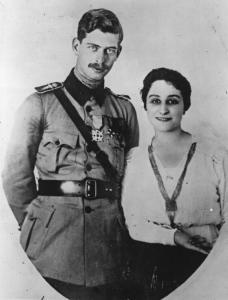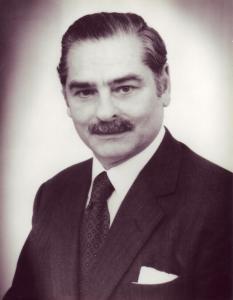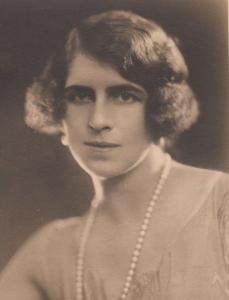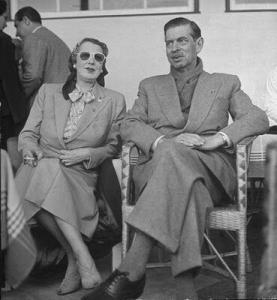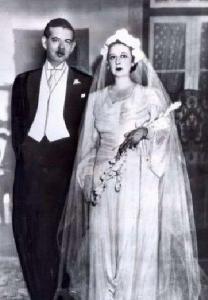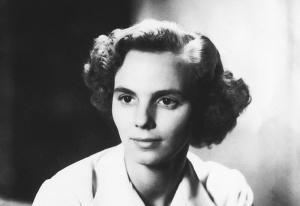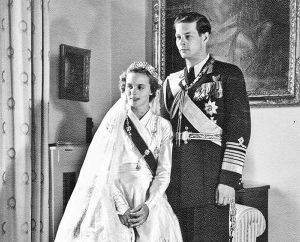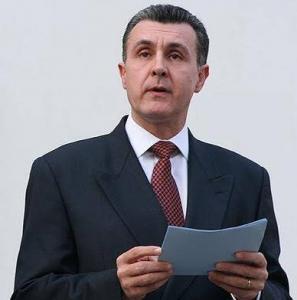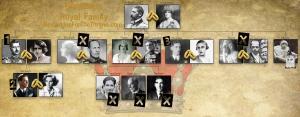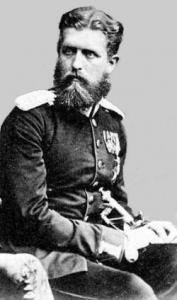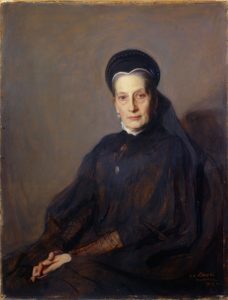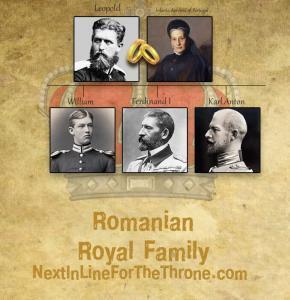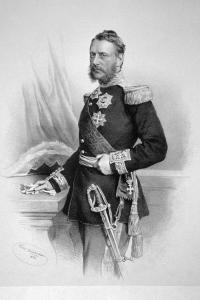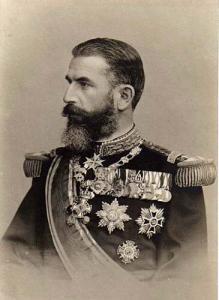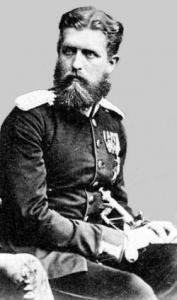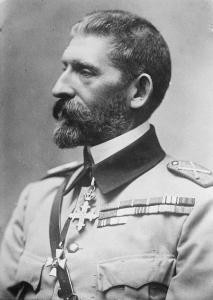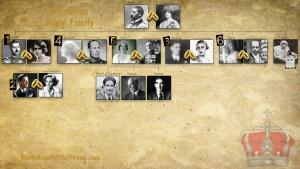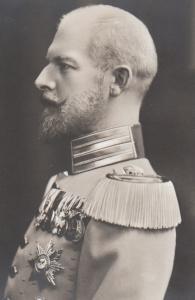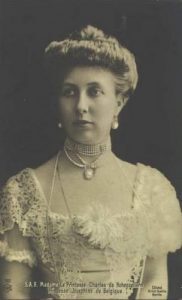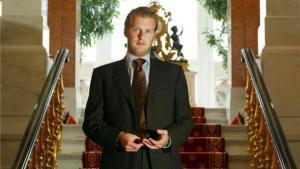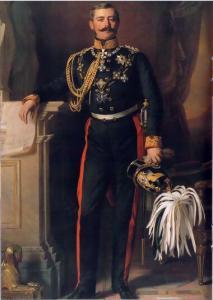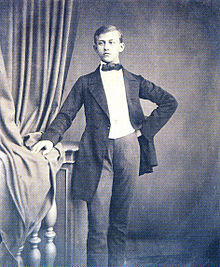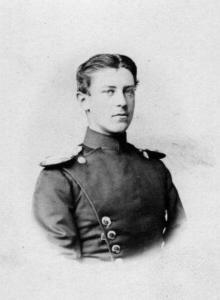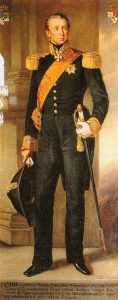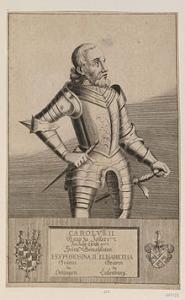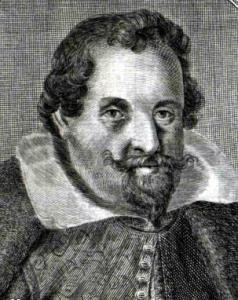My research into the Romanian royal family has been quite honestly, a true labor of love and I’m not anywhere near done.
There are several members of the Romanian Royal family that are in the line of succession to the British throne, including Princess Margareta, Princess Elena, Nicholas Medforth-Mills, and his little sister Elisabeta Karina Medforth-Mills … just to name a few.
But they are very much a royal family in their own right. Before the revolution, Romania was known as the Kingdom of Romania and was a constitutional monarchy.
King Michael of Romania was the last reigning monarch before being sent off to live in exile. King Michael ruled Romania from July 20, 1927, to June 8, 1930, and then again from September 6, 1940, until his forced abdication on December 30, 1947. King Michael died on December 5, 2017, leaving his daughter to carry on the family legacy, if in nothing else, symbolically.
King Michael was the great-grandson of Queen Victoria, making him a third-degree cousin of Queen Elizabeth.
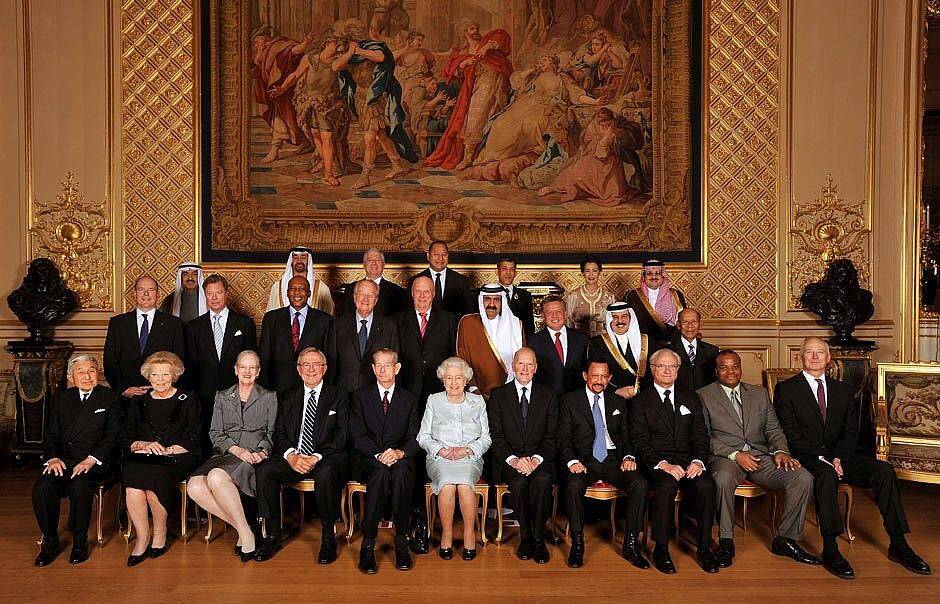
The Romanian Line of Succession
The titles of the members of the Royal House of Romania, as well as the order of succession, are determined by the Organic Norms of the Royal House of Romania.
Thus, according to them, the current head of the Royal House of Romania is Her Majesty, Queen Margareta. The current consort of the head of the Royal House of Romania is Prince Radu.
- Princess Elena of Romania
- Elisabeta Karina of Romania
- Princess Sofia of Romania (Sophie)
- Elisabeta Maria of Romania
- Princess Maria of Romania
So now, let’s move forward to the Romanian Royal Family and discuss their line in detail.
Ferdinand I married Marie of Edinburgh. It was Marie who was born into the British royal family. She was titled Princess Marie of Edinburgh at birth. Her parents were Prince Alfred, Duke of Edinburgh (later Duke of Saxe-Coburg and Gotha), and Grand Duchess Maria Alexandrovna of Russia.
After refusing a proposal from her cousin, the future King George V (from the United Kingdom), so instead she was chosen as the future wife of Crown Prince Ferdinand of Romania, the heir apparent of King Carol I of Romania.
Princess Marie was the granddaughter of Queen Victoria of England. Her father, Alfred was Queen Victoria’s fourth child.
Together Ferdinand and Marie had six children.
- Carol II of Romania
- Elisabeth, Queen of the Hellenes
- Maria, Queen of Yugoslavia
- Prince Nicholas
- Princess Ileana
- Prince Mircea
The Romanian Royal Family
Prince Mircea, their youngest child died when he was only three, but at the time he was born, he would have been third in the line of succession for the Romanian crown. Romanian law doesn’t allow a female to take the crown so only the male lines will be able to produce heirs.
As with tradition, the Ferdinand’s eldest son was Carol II. That made him next in line for the throne. Carol II married a woman by the name of Joanna Marie Valentina “Zizi” Lambrino in 1918, and within a year, his father, the king, would annul the marriage, making the one child they had together (Carol Lambrino) no longer a legitimate heir to the throne.
Born Mircea Grigore Carol Lambrino on January 8, 1920. His mother (Joanna Marie Valentina “Zizi” Lambrino) was the first morganatic wife of Carol II. A morganatic marriage, sometimes called a left-handed marriage, is a marriage between people of unequal social rank, which in the context of royalty prevents the passage of the husband’s titles and privileges to the wife and any children born of the marriage.
Zizi was the daughter of a Romanian Colonel (later promoted to General), and the two met during World War I. Even though his parents opposed their union, he is said to have smuggled her across the Ukranian frontier and they were married in the Orthodox Cathedral of Odessa, Ukraine, on August 31, 1918. His father was furious and ordered him to be held in confinement in the Bistrita Monastery for 75 days. The Bistrița Monastery is a Romanian Orthodox monastery (first founded in 1402) located in a small town of Bistrita, which is about 225 miles north of Bucharest.
In August 1919 the Romanian Supreme Court ruled the marriage unconstitutional, unlawful and annulled it. When he did Carol signed documents of renunciation, moving him out of the line of succession. Well at least temporarily. Still, the couple apparently spent some time together because they had a child together. After the marriage was annulled, Carol and the Romanian government continued to pay Lambrino’s maintenance and that of her son in their French exile.
The legality of the annulment of the marriage was not only unchallenged at the time, but significantly, after eventually becoming King, Carol II did not attempt to undo this act nor declare his son Mircea Carol legitimate. Neither did he ever name Mircea as his heir.
Carol II would eventually marry an approved bride, Helen of Greece and Denmark, the daughter of King Constantine I of Greece.
The princess met Carol, Crown Prince of Romania in 1920, who quickly asked her hand in marriage. Despite the bad reputation of the prince, Helen accepted and moved to Romania, where she soon gave birth to their only son, Prince Michael, in 1921.
At the time she was living in exile, as her father was overthrown with the outbreak of World War I. She was taking care of her father who was plagued by disease and depression. So when she made several trips abroad to visit her parents, this gave her husband back in Romania time to stray and he did just that. Eventually falling in love with his mistress Magda Lupescu in 1924.
Magda Lupescu and Carol II of Romania
In 1925, Prince Carol abandoned his wife and renounced the throne in order to live openly with his mistress. Distraught, Helen tried to persuade her husband to return to her but eventually, she accepted the divorce in 1928.
In the meanwhile, Helen was proclaimed “Queen Mother of Romania” in 1927, as her son Michael ascended to the throne under the regency of his uncle Prince Nicholas. However, the political situation in Romania was complicated, and Carol took advantage of the increased instability to return to Bucharest in 1930 and be acclaimed as king. Soon, the new ruler forced his ex-wife into exile and only authorized her to see their son for two months per year.
Eventually, Carol II was disposed, and his son Michael took the throne again.
This freed his father up to eventually marry his former mistress, Magda Lupescu (aka Elena Lupescu), in 1947. Carol would die a few years later, in 1953, of a heart attack.
With King Michael back in power he could now get down to the business of getting married and producing an heir or two. He married Princess Anne of bourbon-Parma in 1948. Anne was born in Paris, France, the only daughter of Prince René of Bourbon-Parma and Princess Margaret of Denmark. The couple would remain married until her death on August 1, 2016.
Michael and Anne met while in London for the wedding of Queen Elizabeth and Prince Philip Mountbatten. Sixteen days after the first meeting, Michael proposed to Anne while the couple was out on a drive in Lausanne, Switzerland. She initially declined, but later accepted after taking long walks and drives with him.
As a Bourbon, Anne was a Roman Catholic and by marrying her, this meant that Michael was officially removed from the line of succession to the British throne — even though he himself was a non-Catholic Christian.
The couple had five children, all daughters. All of his daughters have been married and three of whom have children of their own.
According to the succession provisions of the Romanian kingdom’s last democratically approved monarchical constitution of 1923, upon the death of King Michael without sons, the claim to the Crown devolves once again upon the Hohenzollern family. So because of the defunct royal constitutions of 1923 and 1938 women were barred from wearing the crown, and Margareta and her sisters would not be in the line of succession to the throne.
According to the succession provisions of the kingdom’s suspended constitution, that of 1938, agnatic primogeniture and so-called “Salic law” determine who would inherit the throne. In theory, it would keep going back one generation until finally a male heir is found. However, in 2007, King Michael issued a ruling in which he called for the first in the line of succession to be his eldest daughter. This would match a private statue he made in 1997, where he designated his oldest child, Princess Margaretaa success to all his prerogatives and rights.
King Michael’s eldest daughter, Princess Margareta, married a man by the name of Radu Duda. He’s not of royal blood. He’s the son of two highly educated professors, Dr. René Corneliu Duda and his wife Dr. Gabriela Eugenia Duda née Constandache. In 2007 he had his legal name changed from “Radu Duda” to “Radu al României Duda”, basically meaning something like Radu of Romania.
As the spouse of the heir to the Crown Princess, Radu often accompanies his wife, sometimes even solo, to support social projects and promote the Romanian economy.
He is also the patron and a member of numerous Romanian charities and organizations.
If you go with the old rules, where women couldn’t inherit the crown, you would have to go back Ferdinand, there you just have three males. Carol II (Michael’s father so he’s out), Prince Nicholas, and Prince Mircea.
- Carol only had one legitimate son, Michael.
- Nicholas had no children of his own.
- Mircea died at the age of three.
Prince Nicholas married twice. The second marriage was to Ioana (Joanna) Dumitrescu-Doletti Thereza Lisboa Figueira de Mello on July 2, 1936. She was a divorcee and commoner, and as such his father did not approve. As a result of this union, he was stripped of his royal privileges and titles and exiled from Romania. He left for Spain but ultimately settled in Switzerland.
His second marriage was to a Brazillian woman named Maria Thereza Lisboa Figueira de Mello on July 13, 1967. As far as I can tell, he had no children of his own, from either marriage.
So that means we then have to go back to another generation to find a legitimate male heir. Ferdinand’s father was Leopold, Prince of Hohenzollern.
He was married to Infanta Antónia of Portugal was a Portuguese infanta (princess) of the House of Braganza, daughter of Queen Maria II of Portugal, and her King consort Ferdinand II of Portugal. Through her father, she also held the titles of Princess of Saxe-Coburg and Gotha and Duchess of Saxony.
Together they had three sons.
- Prince William, Prince William, Prince of Hohenzollern
- King Ferdinand I of Romania
- Prince Karl Anton
Leopold is a German Prince from the Princely House of Hohenzollern. He renounced his rights to the Romanian succession in favor of his sons in 1880.
I’m not a constitutional lawyer, from what I understand when it deals with succession you go back one generation to the eldest male. However in this case, on December 20, 1886, William renounced his rights to the throne in favor of his brother Ferdinand.
So since he renounced his rights, that brings us to his little brother Karl Anton.
How did the royal family of Romania begin?
This is Alexandru Ioan Cuza. He was known as the Dominator (Ruler) of Romania from 1862-1866. He initiated a series of reforms that contributed to the modernization of Romanian society and of state structures.
Cuza was forced to abdicate on February 22, 1886, by a group of military conspirators who broke into the palace and forced the prince to sign his abdication.
His successor was Karl, Prince of Hohenzollern-Sigmaringen (who went by Carol I of Romania). He was elected Sovereign Prince of Romania on April 20, 1866. He ruled Romania from 1866 to 1914, first as Ruling Prince and finally as King on March 26, 1881.
Karl Eitel Friedrich Zephyrinus Ludwig had a daughter named Princess Maria and since she couldn’t inherit the throne, it went to his brother’s son.
Carol’s father was also named Karl Anton, Prince of Hohenzollern. This Karl Anton had six children.
- Leopold, Prince of Hohenzollern
- Stephanie, Queen of Portugal
- Karl Anton (aka Carol I, King of Romania)
- Prince Anthony
- Prince Frederick
- Princess Marie, Countess of Flanders
Carol I of Romania didn’t have a son so he needed a male heir. His older brother was in line to inherit the Prince of Hohenzollern, so that meant the next male in line would be Leopold’s second son.
Leopold, Prince of Hohenzollern was the head of the Swabian branch of the House of Hohenzollern, so he couldn’t very well go be King of Romania. So he renounced his rights to the Romanian succession in favor of his sons in 1880. Leopold had three sons. William, Prince of Hohenzollern (his own heir), then there was Ferdinand I of Romania, and last but not least, Prince Karl Anton.
This brings us back to Ferdinand I of Romania.
Romanian Royal Line of Succession
Ferdinand has 6 kids, 3 males, 3 females.
- Carol II – Michael I – No male heirs
- Nichols – had no children
- Mircea – had no children (died as a child)
His daughter Elisabeth had no children of her own. His daughter Maria had 3 sons, but they all belong to the royal line of Yugoslavia. Then there is his daughter Ileana.
While she had six of her own children, there is some question about her real father. The rumor is that her true father is her mother’s lover Prince Barbu Stirbey. Even though the king claimed her as his own, this rumor of her parentage would have always followed her as well as all of her children, so it is highly unlikely any of her children would ever be considered.
That being said, we then have to backtrack to get to Prince Karl Anton, Leopold’s youngest son.
Prince Karl Anton married Princess Joséphine Caroline of Belgium and together they had 4 children, three daughters, and one son.
- Princess Stephanie
- Princess Marie Antoinette
- Prince Albrecht
- Princess Henriette
This means that Prince Albrecht’s sons would be the legit line of male heirs to the Romanian throne.
Prince Albrecht Ludwig Leopold Tassilo of Hohenzollern (28 September 1898 – 30 July 1977) married Ilse Margot von Friedeburg on 19 May 1921. They have five children one of whom was a son, and therefore the heir.
- Princess Josephine Wilhelma of Hohenzollern-Sigmaringen (15 February 1922)
- Princess Luise-Dorothea of Hohenzollern-Sigmaringen (9 February 1924 – November 1988) she married Egbert Count of Plettenberg on 11 June 1947. They have seven children.
- Princess Rose-Margarethe of Hohenzollern-Sigmaringen (19 February 1930) she married Edgar Pfersdorf on 15 September 1955. They have four children.
- Princess Maria of Hohenzollern-Sigmaringen (1 April 1935 – 1 April 1935) she died at one day old.
- Prince Godehard-Friedrich of Hohenzollern-Sigmaringen (17 April 1939) he married Heide Hansen on 29 August 1971. They have two children.
Prince Godehard-Friedrich of Hohenzollern-Sigmaringen (17 April 1939) he married Heide Hansen on 29 August 1971. They have two children. Godehard-Friedrich Prinz von Hohenzollern died on May 21, 2001, at the age of 62. He had a son Carlos, and a daughter named Anna.
His son, Carlos Patrick Godehard Prinz von Hohenzollern is most likely the true heir to the Romanian throne.
But things can never be that easy, now can they?
HSH Prince Carlos Patrick Godehard of Hohenzollern died by suicide on February 23., 2018 It was reported that he jumped from the roof terrace on the 21st floor at Frankfurt-am-Main’s Intercontinental Hotel.
The 39-year-old prince had been released from jail a few days before where he had served a four-year sentence for swindling. He had been serving his time at the Euskirchen prison and was due for release in July. As a part of his preparation for a full release in July, Prince Carlos had been allowed a brief break away from prison. He left the prison and drove more than 200 miles to Frankfurt. It is not known if Carlos had checked into the hotel. He went to the roof terrace and jumped. His body was found at 2:40 p.m. His death was instantaneous. Frankfurt police have ruled out the death as an accident. Prince Carlos frittered away his inheritance with numerous bad business deals, which to several convictions. In 2011, he was sentenced to four month’s probation for non-payment of a bill to one of his creditors. Three years later he was sentenced to four years for “dealing in multi-million-pound investment funds which did not exist,” according to the Daily Mail. Prince Carlos had no children of his own. That means no heirs.
So this brings us back to Leopold’s generation.
Leopold’s father was Karl Anton, Prince of Hohenzollern, also known as Karl Anton Joachim Zephyrin Friedrich Meinrad of Hohenzollern-Sigmaringen. He had 5 kids.
Karl Anton Joachim Zephyrin Friedrich Meinrad of Hohenzollern-Sigmaringen
- Leopold, Prince of Hohenzollern
- Stephanie, Queen of Portugal
- Carol I, King of Romania
- Prince Anthony
- Prince Frederick
- Princess Marie, Countess of Flanders
We already know that any females are out so that brings us to Prince Anthony, or more officially Prince Anton of Hohenzollern-Sigmaringen.
Sadly he died young while serving in the military and did not have a wife. Which then brings us to Prince Frederick.
Prince Frederick married Princess Louise of Thurn and Taxis, yet they didn’t have children.
Who would have ever thought it would be so hard to find a single male heir! But here we are, going back yet another generation!
This is Karl, Prince of Hohenzollern-Sigmaringen, not to be confused with his son, also by the same name.
This Prince Karl had 4 children, but only one son, Karl, who we’ve already determined had no available male heirs.
So we go back yet one more generation to Anton Aloys, Prince of Hohenzollern-Sigmaringen. This guy was born in 1762. He married Princess Amalie Zephyrine of Salm-Kyrburg. But they had only one child, Charles, who we just ruled out as having any available male heirs.
So we go back one more generation to Karl Friedrich, who was born on January 9, 1724.
- Friedrich Joseph Fidelis Anton (29 May 1750 – 17 August 1750)
- Johann Baptist Friedrich Fidelis (born and died 18 August 1751)
- Anton Joachim Georg Franz (12 July 1752 – 1 November 1752)
- Fidelis Joseph Anton Franz (11 July 1753 – 6 February 1754)
- Marie Franziska Anna Antonia (8 August 1754 – 22 April 1755)
- Joachim Adam (15 August 1755 – 22 March 1756)
- Joseph Friedrich Fidelis (17 June 1758 – 12 September 1759)
- Franz Konrad Maria Fidelis (12 July 1761 – 18 July 1762)
- Anton Aloys Meinrad Franz (20 June 1762 – 17 October 1831), Prince of Hohenzollern-Sigmaringen
- Fidelia Theresia Karoline Creszentia (27 October 1763 – 3 November 1763)
- Johanna Franziska Antonia (3 May 1765 – 23 August 1790), married in 1781 to Frederick III, Prince of Salm-Kyrburg
- Maria Kreszentia (23 July 1766 – 5 May 1844), created Lady of Holzen on 12 June 1813; married in 1807 to Franz Xaver Fischler, Count of Treuberg
As we’ve already ruled out Anton Aloys, we have to go back yet another generation as all of Anton’s remaining siblings were female.
Karl Friedrich, who was born on January 9, 1724, was the son of Prince Joseph Ernst Friedrich Karl Anton Meinrad of Hohenzollern-Sigmaringen. He was born on May 24, 1702, and he married Maria Franziska Louise and they had six children.
- Karl Friedrich (9 January 1724 – 20 December 1785), Prince of Hohenzollern-Sigmaringen.
- Maria Johanna (13 November 1726 – 9 April 1793), a nun in Buchau.
- Maria Amalia Franziska (8 May 1729 – 4 March 1730).
- Meinrad Ferdinand Joseph (20 October 1732 – 8 June 1733).
- Maria Anna Theresia (born and died 16 August 1736).
- A son (born and died 29 November 1737).
As we’ve already ruled out Karl Friedrich, we skip down to the next male heirs, none of which survived past childhood. But as it turns out Prince Joseph Ernst Friedrich Karl Anton Meinrad of Hohenzollern-Sigmaringen married twice and they had three children.
On 5 July 1738, Joseph married secondly with Maria Judith Katharina Philippina (30 April 1718 – 9 May 1743), daughter of Count Franz Anton of Closen, Baron of Arnstorf. They had three children:
- Karl Albrecht Joseph (24 March 1741 – 23 May 1741).
- Maria Amalia Josepha (29 May 1742 – 27 August 1742).
- Maria Theresia Philippina (15 April 1743 – 11 August 1743).
Yet sadly the only male didn’t survive past infancy.
When it comes to Primogeniture, it really can be hard to find a legitimate heir.
Primogeniture (for those who don’t know) is the right, by law or custom, of the firstborn legitimate son to inherit his parent’s entire or main estate, in preference to shared inheritance among all or some children, a child other than the eldest male, a daughter, illegitimate child or a collateral relative. In some cases, the estate may instead be the inheritance of the firstborn child or occasionally the firstborn daughter. The descendant (often the son) of a deceased elder sibling (typically elder brother) inherits before a living younger sibling by right of substitution for the deceased heir. In the absence of any children, brothers succeed, individually, to the inheritance by seniority of age (subject to substitution). Among siblings, sons usually inherit before daughters.
Primogeniture prevents the subdivision of estates and diminishes internal pressures to sell the property (for example, if two children inherit a house and neither can afford to buy out the other’s share). The Romanian monarchy follows what is called Salic law which is an agnatic seniority primogeniture system that excludes any female from the inheritance of a monarch’s principal possessions.
Due to this law, we have already worked our way through countless generations to find a legitimate male heir, so far without any luck.
So let’s go back yet one more generation, to Meinrad II Charles Anthony of Hohenzollern-Sigmaringen. He was born on November 1, 1673. He married Johanna Katharina von Montfort. They had four children, three males, one female.
- Joseph Friedrich Ernst (1702–1769)
- Anna Maria (1707–1783)
- Franz Wilhelm (1704–1737)
- Charles Wolfgang (1708–1709)
So this brings us to Franz Wilhelm who married Countess Marie Catharina of Waldburg-Zell-Trachburg in 1724. They had two children, a daughter, and a son.
- Countess Johanna of Hohenzollern-s’Heerenberg,
- Johan Baptist, Count van den Bergh
Johan Baptist, Count van den Bergh was born in 1728 and died in 1781. It seems he married a woman by the name of Maria Benonia Gräfin von Lodron, but they didn’t seem to have any children.
Since his younger brother Charles Wolfgang died in infancy, that means we have to go back yet another generation to find our heir.
This takes us to Maximilian I, Prince of Hohenzollern-Sigmaringen. He was born on January 20, 1636, and he married Maria Clara in 1666. She was the daughter of Count Albert of Berg-‘s-Heerenberg. Together they had 12 children.
- Anna Maria (1666-1668)
- Maria Magdalena Clara (1668-1725), a nun in Gnadenthal Abbey
- Cleopha Maria Theresa (1669-1731), a nun in Buchau Abbey
- Meinrad II Charles Anthony (1673-1715), Prince of Hohenzollern-Sigmaringen
- Francis Albert Oswald (1676-1748), a canon in Cologne
- Francis Henry (1678-1731), a canon in Cologne and Augsburg
- Charles Anthony (1679-1684)
- Anthony Sidonius (1681-1719)
- John Francis Anthony (1683-1733)
- Maximilian Froben Maria (1685-1734), a monk
- Charles (1687-1689)
- Friederike Christiane Maria (1688-1745)
Out of those 12 children, their eldest son was Meinrad II Charles Anthony of Hohenzollern-Sigmaringen, who was born in 1673, but we’ve previously ruled his line out.
So that brings us to Franz Albert Oswald von Hohenzollern-Sigmaringen who was born in 1676. Like his brother Francis Henry, he was a canon and didn’t seem to marry, let alone have children.
Charles Anthony died as a child so that takes us to Anthony Sidonius von Hohenzollern-Sigmaringen. In 1712 he married Countess Maria Josepha of Verdenberg and Namiest. As far as I can tell they did not have any children.
So that takes us to Johann Franz Anton von Hohenzollern-Sigmaringen (aka John Francis Anthony) who was born in 1683. It appears he married twice, the first time to Maria Barbara Everhardt of Lightem Haag in 1712 and then later to Maria Antonia of Frauenberg.
There appear to be no children from these two unions.
Maximilian Froben Maria was a monk so he never married nor had any children. Charles (aka Karl) died in infancy so that brings us back amazingly to the previous generation. Actually, we go back two generations as Meinrad I had no brothers, only two sisters.
So this brings us back to Charles II, Count of Hohenzollern-Sigmaringen (aka Karl II, Graf von Hohenzollern-Sigmaringen) – grandfather of Meinaad I, father of Johann.
Charles II married Euphrosyne, daughter of Frederick V, Count of Oettingen-Wallerstein. They had fifteen children:
- Ferdinand (24 August 1571 – 1 November 1571)
- Anna Marie (1 June 1573 – 1 June 1598)
- Maria Magdalena (9 January 1574 – 2 January 1582)
- Barbara (11 January 1575 – 15 May 1577)
- Maria Jakobe (3 January 1577 – 18 March 1650)
- Johann (17 August 1578 – 22 March 1638)
- Karl (24 September 1579 – 23 March 1585)
- Euphrosyne (6 November 1580 – 4 February 1582)
- Eitel Friedrich (26 September 1582 – 19 September 1625)
- Maria Maximiliane (31 October 1583 – 11 September 1649)
- Ernst Georg (7 May 1585 – 19 April 1625)
- Maria Eleonore (29 October 1586 – 1668)
- Maria Sabine (12 November 1587 – 1590)
- Jakob Friedrich (9 August 1589 – 25 August 1589)
- Maria (born and died 15 September 1590)
After Johann, which we’ve already discounted his line we have Karl who died as a child, then there is Eitel Friedrich, who as a Roman Catholic Cardinal and Prince Bishop, never married or had offspring. So we skip forward to Ernst Georg, who did marry but he had only two daughters, no sons. So next we come to Jakob Friedrich who died as an infant.
So now we must look at Charles II’s second married. He married Elisabeth, the daughter of Freiherr of Palant and Count of Cuylenburg and widow of James III, Margrave of Baden-Hachberg. They had ten children:
- Maria Elisabeth (10 January 1592 – 28 October 1659)
- Georg Friedrich (16 March 1593 – 9 May 1593)
- Maria Salome (2 February 1595 – 10 November 1595)
- Maria Juliane (4 February 1596 – 1669)
- Philipp Eusebius (30 January 1597 – 3 November 1601)
- Christian (born and died 3 February 1598)
- Maria Cleopha (11 June 1599 – 26 February 1685)
- Maria Christiane (22 May 1600 – 1634)
- Maria Katharine (24 November 1601 – 1602)
- Maria Amalie (1 January 1603 – ?)
It’s easy to look at someone like Charles II and wonder why after having 15 kids with his first wife, did he need to have ten more with his second wife. But if you consider just how hard it is to have a male child who not only lives to be an adult but then himself goes on to get married and have males who live to adulthood. Then you begin to see just why men back then had so many children.
His eldest son from his 2nd marriage died as an infant. His next son, Philipp Eusebius died as a toddler. His next son Christian died the day he was born, which means he had no male heirs that went on to have male heirs – even after having 25 children. That wasn’t enough to produce a male heir that would go on to produce his own male heir.
So going back a generation we come to Karl I Graf von Hohenzollern who was born in 1516. He had 15 children.
- Ferfried von Hohenzollern b. 1538, d. 1556
- Ernst von Hohenzollern b. 1539, d. 1539
- Jacob von Hohenzollern b. 1543, d. 1543
- Marie von Hohenzollern b. 1544, d. 1611
- Eitel Friedrich IV Graf von Hohenzollern-Hechingen+ b. 7 Sep 1545, d. 16 Jan 1605
- Karl II Graf von Hohenzollern-Sigmaringen+1 b. 22 Jan 1547, d. 1606
- Johanna von Hohenzollern b. 1548, d. 1604
- Marie Jakobe von Hohenzollern b. 1549, d. 1578
- Eleonore von Hohenzollern b. 1551, d. a 11 Oct 1598
- Christof von Hohenzollern-Haigerloch b. 1552, d. 1592
- Magdalene von Hohenzollern b. 1553, d. a 11 Jun 1571
- Joachim von Hohenzollern b. 1554, d. 1587
- Christine von Hohenzollern b. 1555
- Amalie von Hohenzollern b. 1557, d. 1603
- Kunigunde von Hohenzollern b. 1558, d. 1595
Christof von Hohenzollern-Haigerloch married Catherine, a daughter of Baron Baron Christoph of Welsperg. Together they had six children.
- Johann Christoph (1586-1620), Count of Hohenzollern-Haigerloch
- Karl (1588-1634), Count of Hohenzollern-Haigerloch
- Gwendolyn Marie Salome (1578-1647), a nun in the Inzigkofen Abbey
- Anna Dorothea († 1647), Prioress at Inzigkofen Abbey
- Marie Sidonia, a nun at Söflingen Abbey
- Jakobe (died after 1607)
Johann Christoph served in the imperial army and lived mostly in Vienna. In 1608 in Sigmaringen, he married his cousin Marie (1592–1658), a daughter of his erstwhile guardian Count Karl II of Hohenzollern-Sigmaringen. They, however, had no children.
His brother Karl married but he too had no children. This means that we have to go back to Karl’s other sons. After Christof, there was which was the 4th surviving son of Count Karl I of Hohenzollern from his marriage to Anna, the daughter of Ernst, Margrave of Baden-Durlach.
On 6 July 1578, Joachim of Zollern (aka Joachim von Hohenzollern) married Anna, the daughter of Count Volkmar Wolf of Hohnstein.
They had one son, Johann Georg (aka Johann Georg Graf v. Hohenzollern) who was born in 1580. He married Baroness Elonore of Promnitz in 1606 and in 1613 he married Baroness Katharina Berka of Duba and Leipa.
From his marriage with Baroness Elonore, he had 5 children. No male lived past childhood.
- Anna Ursula, Gräfin von Hohenzollern , b. 16 Feb 1607, d. Aft 2 Mar 1640
- Gräfin Eleonora Dorothea von Hohenzollern, b. 10 Feb 1608, d. 7 Aug 1609 (Age 1 years)
- Graf Joachim Seifried von Hohenzollern, b. 1 Nov 1609, d. 29 Dec 1609 (Age 0 years)
- Graf Georg Friedrich von Hohenzollern, b. 19 Sep 1610, d. 31 May 1616 (Age 5 years)
- Graf NN von Hohenzollern, b. 19 Dec 1611, (stillborn)
From his marriage with Baroness Katharina, he had 6 children.
- Gräfin Anna Barbara von Hohenzollern, b. 19 Oct 1613, d. 1 Nov 1613 (Age 0 years)
- Gräfin Helene von Hohenzollern, b. 7 Feb 1615
- Gräfin Marie Elisabeth von Hohenzollern, b. 24 May 1616
- Graf Karl von Hohenzollern, b. 8 Apr 1617, d. 18 Apr 1617 (Age 0 years)
- Gräfin Anna Katharina von Hohenzollern, b. 4 May 1618, d. 15 Feb 1670 (Age 51 years)
- Gräfin Esther von Hohenzollern, b. 21 Oct 1620
No male children lived past infancy.
Karl I had no further male children, so we now skip to Karl I’s father, Eitel Friedrich III, Graf von Hohenzollern. He was born in 1494. He married Johanna van Witthem in 1537 and they had 15 children.
- Graf Ferfried von Hohenzollern-Sigmaringen, b. 28 May 1538, d. 14 Jul 1556 (Age 18 years)
- Graf Ernst von Hohenzollern-Sigmaringen, b. 3 May 1539, d. 10 May 1539 (Age 0 years)
- Graf Jakob von Hohenzollern-Sigmaringen, b. 1543, d. 1543 (Age 0 years)
- Gräfin Marie von Hohenzollern-Sigmaringen, b. 28 Aug 1544, d. 13 Dec 1611 (Age 67 years)
- Eitel Friedrich I, Graf von Hohenzollern-Hechingen , b. 7 Sep 1545, Sigmaringen, d. 16 Jan 1605 (Age 59 years)
- Karl II, Graf von Hohenzollern-Sigmaringen , b. 22 Jan 1547, d. 8 Apr 1606 (Age 59 years)
- Johanna, Gräfin von Hohenzollern-Sigmaringen , b. 23 Jun 1548, d. 22 Feb 1604, Wallerstein (Age 55 years)
- Marie Jakobe, Gräfin von Hohenzollern-Sigmaringen , b. Jul 1549, d. 1578 (Age ~ 28 years)
- Gräfin Eleonore von Hohenzollern-Sigmaringen, b. 15 Feb 1551, d. Aft 11 Oct 1598 (Age 47 years)
- Christof, Graf von Hohenzollern-Sigmaringen zu Haigerloch , b. 20 Mar 1552, d. 21 Apr 1592 (Age 40 years)
- Gräfin Magdalene von Hohenzollern-Sigmaringen, b. 17 Apr 1553, d. Aft 11 Jun 1571 (Age 18 years)
- Graf Joachim von Hohenzollern, b. 21 Jun 1554, d. 7 Jul 1587 (Age 33 years)
- Gräfin Christine von Hohenzollern-Sigmaringen, b. 27 Oct 1555, d. , young
- Gräfin Amalie von Hohenzollern-Sigmaringen, b. 18 Jan 1557, d. 1603 (Age 45 years)
- Gräfin Kunigunde von Hohenzollern-Sigmaringen, b. 10 Sep 1558, d. 1595 (Age 36 years)
Eitel Friedrich I, Graf von Hohenzollern-Hechingen , was born in 1545. He married Veronika, Gräfin Veronika von Ortenburg in 1568 but she died just a few years later in 1573. They had no children. His next wife was Sibylle, Gräfin von Zimmern. He married her in 1574 and they had 4 children.
- Graf Ernst von Hohenzollern-Hechingen, b. 1575, d. , young
- Johann Georg, Fürst von Hohenzollern-Hechingen , b. 1577, Hechingen, d. 28 Sep 1623, Hechingen, (Age 46 years)
- Gräfin Maximiliane von Hohenzollern-Hechingen, b. 2 Feb 1580, d. 24 Jul 1633 (Age 53 years)
- Gräfin Johanna von Hohenzollern-Hechingen, b. 1581, d. 26 Apr 1634 (Age 53 years)
His song Johann Georg, was born in 1577 and he married Franziska, Gräfin von Salm, Wild- und Rheingräfin in Neufville in 1598. They had 15 children.
- Prince Karl von Hohenzollern-Hechingen, b. 1599, d. 1599 (Age 0 years)
- Princess Sibylle von Hohenzollern-Hechingen, b. Est 1600, d. 8 Aug 1621, Schleiden (Age ~ 21 years)
- Franziska Katharina, Prinzessin von Hohenzollern-Hechingen , b. Est 1601, d. 16 Jun 1665, Hohenems Find all individuals with events at this location (Age ~ 64 years)
- Eitel Friedrich II, Fürst von Hohenzollern-Hechingen , b. Jan 1601, d. 11 Jul 1661, Isenheim, Alsace (Age ~ 60 years)
- Prince Johann Friedrich von Hohenzollern-Hechingen, b. 1602, d. 1602 (Age 0 years)
- Anna Maria, Prinzessin von Hohenzollern-Hechingen , b. 8 Sep 1603, d. 23 Aug 1652, Düsseldorf (Age 48 years)
- Prince Georg Friedrich von Hohenzollern-Hechingen, b. Est 1604, d. 1633, Uttenweiler (in battle) Find all individuals with events at this location (Age ~ 29 years)
- Princess Marie Domina von Hohenzollern-Hechingen, b. Est 1605, d. , young
- Princess Katharina Ursula von Hohenzollern-Hechingen, b. Est 1606, in Hechingen, d. 2 Jun 1640, Baden Find all individuals with events at this location (Age ~ 34 years)
- Marie Renate, Prinzessin von Hohenzollern-Hechingen , b. Est 1607, d. 12 Jan 1637, Konstanz (Age ~ 30 years)
- Maximiliane, Prinzessin von Hohenzollern-Hechingen , b. Est 1609, d. 10 Apr 1639, Wien (Age ~ 30 years)
- Prince Leopold Friedrich von Hohenzollern-Hechingen, b. Est 1611, d. 19 Jun 1659, Köln (Age ~ 48 years)
- Maria Anna, Prinzessin von Hohenzollern-Hechingen , b. 1614, d. 7 Mar 1670, Albi, Tarn (Age 56 years)
- Philipp, Fürst von Hohenzollern-Hechingen 1661-1671 , b. 24 Jun 1616, Hechingen , d. 13 Jan 1671, Hechingen (Age 54 years)
- Prince(ss) NN von Hohenzollern-Hechingen, b. 1 Dec 1619, Hechingen Find all individuals with events at this location, d. Dec 1619, Hechingen (Age 0 years)
Philipp, Fürst von Hohenzollern-Hechingen was born in 1661. He was the only male child who had male children in this line. He married Marie Sidonie, Markgräfin von Baden and they had 8 children.
- Friedrich Wilhelm, Fürst von Hohenzollern-Hechingen 1671-1735 , b. 20 Sep 1663, Castle Hechingen Find all individuals with events at this location, d. 14 Nov 1735, Castle Hechingen Find all individuals with events at this location (Age 72 years)
- Hermann Friedrich, Graf von Hohenzollern-Hechingen , b. 11 Jan 1665, Schloss Hechingen Find all individuals with events at this location, d. 23 Jan 1733, Freiburg Find all individuals with events at this location (Age 68 years)
- Graf Leopold von Hohenzollern-Hechingen, b. 11 Feb 1666, Castle Hechingen Find all individuals with events at this location, d. 18 Jul 1684, Budapest (in battle) Find all individuals with events at this location (Age 18 years)
- Graf Philipp von Hohenzollern-Hechingen, b. 9 Feb 1667, Castle Hechingen Find all individuals with events at this location, d. 30 Jun 1667, Castle Hechingen Find all individuals with events at this location (Age 0 years)
- Gräfin Maria Margarete von Hohenzollern-Hechingen, b. 22 May 1668, Hechingen Find all individuals with events at this location
- Graf Karl von Hohenzollern-Hechingen, b. 5 Aug 1669, Castle Hechingen Find all individuals with events at this location, d. 5 Aug 1669, Castle Hechingen Find all individuals with events at this location (Age 0 years)
- Gräfin Marie Margarete von Hohenzollern-Hechingen, b. 26 Apr 1670, Castle Hechingen Find all individuals with events at this location, d. 20 Apr 1687, Strasburg Find all individuals with events at this location (Age 16 years)
- Graf Franz Leopold Joachim von Hohenzollern-Hechingen, b. 25 Apr 1671, Castle Hechingen Find all individuals with events at this location, d. 25 Apr 1671, Castle Hechingen Find all individuals with events at this location (Age 0 years)
